Operations Report – April 24th
Crew 280 Operations Report 24-04-2023
SOL:8
Name of person filing report: Neus Sabaté (Mission Specialist)
Non-nominal systems:
Robotic Observatory
Notes on non-nominal systems: Replacement parts of Robotic observatory are scheduled to be installed during crew 261 rotation.
ROVERS
Spirit rover used: yes
Hours: 217.5
Beginning charge: 100%
Ending charge: 70%
Currently charging: yes
Opportunity rover used: no
Hours: 121.9
Beginning charge: –
Ending charge: –
Currently charging: yes
Curiosity rover used: no
Hours: 231.0
Beginning charge: –
Ending charge: –
Currently charging: yes
Perseverance rover used: yes
Hours: 262.0
Beginning charge: 100%
Ending charge: 65%
Currently charging: yes
General notes on rovers: none
Summary of Hab operations:
WATER USE: 31 gal (from 6PM Sol4 to 6PM Sol5)
Water (static tank): 320 gal (at 6:00PM)
Static tank pipe heater: off
Static tank heater: off
Toilet tank emptied: no
Summary of internet: used from 18:00 to 21:00 for personal communication and reports.
Summary of suits and radios:
Suits: 2,3,6 and 8.
Radios: nominal
All radio and spacesuit batteries checked before EVA: Yes. All nominal.
Summary of GreenHab operations: a small mouse was found in the trap. It has been removed by Mission Support.
WATER USE: 14 gallons (+1 gallon for Science Dome)
Heater: Off
Supplemental light: Off
Harvest: 8g rocket, 20g of microbeets/beans, 1g lemon balm, 40g yellow tomatoes, 63g red tomatoes and 60g Salad Mix (seeds for the Crew Project from Laia Ribas).
Summary of ScienceDome operations: Laia Ribas, Neus Sabaté and Cesca Cufí have been working on their experiments.
Dual split: Heat or AC, Off
Summary of RAM operations: use of solder to repair Laia Ribas’ Martian Bottle
Summary of any observatory issues:
Robotic observatory: Not working. Replacement parts are scheduled to be installed during crew 261 rotation.
Summary of health and safety issues: none
Summary of other system’s issues: none
Questions, concerns and requests to Mission Support:
Questions: none
Requests:
Kitchen: knobs replacement – expected next week
Research Report – April 22nd
[category science-report]
Crew 280 Mid-Mission Research Report
Astronomy
Over this past week, the MDRS astronomical facilities have provided a unique opportunity to observe the Martian night sky under limited light pollution. Taking advantage of these great conditions, Mariona Badenas-Agusti (Crew Commander and Astronomer) is combining her management responsibilities at the MDRS with two astronomy-related projects:
● Study of the Solar Chromosphere: The goal of this project is to use the Lunt 1000mm refracting telescope in the Musk Observatory to study the chromosphere of the Sun. During the first days of the mission, the telescope was not properly aligned, so Mariona had to spend some time understanding how to calibrate it properly. After this issue was resolved, she was able to conduct visual observations of the Sun in search for a variety of magnetic phenomena, including sunspots, flares, and granules. To date, she has been able to identify various sunspots through the eyepiece. Her goal for next week is to image these features with the AUTOSTAKKERT software.
● Astrophotography of Deep-Sky Objects: Mariona has also used the MLC-RCOS16 Robotic telescope to generate RGBLHa color images of deep-sky objects, including planetary nebulae (NGC 6888/Crescent Nebula) and galaxies (NGC 4273, NGC 5371, NGC 5033, NGC5055/Messier 63, and NGC 3184/Little Pinwheel Galaxy).
Biology
The Hypatia I crew has several biology-related projects in the fields of microbial, animal and human sciences. The MDRS provides a unique environment to conduct such projects, because it allows you to study how humans and microbial life would develop in Mars, as well as the exterior environment is the perfect place to search for potential Martian biological signatures.
Carla Conejo González (Crew Executive Officer & Biologist) is combining her XO responsibilities at the MDRS with conducting projects on humans factors affecting a mission to Mars, including experiments in the fields of telemedicine, psychology and sociology, as follows:
● Circadian rhythms in a Mars analog mission: a telemetric approach: The goal of this project is to study the sleep-wake cycle of the crew and how their participation in a Martian analog mission at the MDRS is affecting their circadian rhythms. The project has two different approaches: (i) the telemetric approach, where each crew member’s sleep record is being tracked since Sol1 using an actigraphy wearable wrist-worn device (Fitbit ® by Google); (ii) the same register is also recorded using a written sleep log diary, where each crew member has to write down when they went to sleep and woke up, as well as their self-perception of sleepiness during the day. Both digital and analogic records are tracked by each member of the crew, and at the end of the mission will be anonymized for analysis purposes. This project is being conducted in collaboration with the support of Google and the Hospital Germans Trias i Pujol.
● Additional observations: As part of our mission, other observations in the following fields are planned, and will be used to complement the results of the primary experiment.
○ Psychology: Study on the psychological effects of participation in a mission similar to the MDRS, in collaboration with the University of Burgundy (France).
○ Sociology: Study on the social interactions of the crew for the optimization of our performance as a team, in collaboration with the company Sociomapping.
○ Gynecology: Study on the changes in the ovarian function of people subjected to the experimental situation of a similar mission, in collaboration with the Hospital of Sant Pau Hospital.
Laia Ribas (Green Hab Officer & Biologist) is combining her daily responsibilities in the GreenHab together with her research projects. Her projects are developing as follows:
● CatMart:This is an outreach project aimed at identifying microorganisms on Mars. A total of five Martian spots have been sampled, obtaining 200-300 g of soil. The localization in the Martian map are the following: Cowboy Corner (sampled on 20/03/23), Kissing Camel River (sampled on 21/03/23), Robert Garden Rock (sampled on 21/03/23) North Ridge (sampled on 22/03/23), Compass Road (sampled at 23/03/23). The soil samples, kept in zipper plastic bags, were brought to the station for further analysis during the remaining SOLs.
● Martian Bottle. The aim of the experiment is to reduce the number of microorganisms in the water. The water is obtained from the waste watering in the GreenHab. Two experiments are currently ongoing. The figure on the right shows one step of the protocol in which the residual water is diluted (right side in the figure) and divided into two experimental groups, the control (middle) and the Martian bottle (left).
● Aquaculture on Mars. The aim is to study the alteration of the epigenome in zebrafish subjected to hypergravity. The experiments were conducted at the Institute of Marine Sciences (ICM-CSIC, Barcelona). This project is at the forefront of high-sequencing technology through the use of an instrument called MinION. Unfortunately, due to the delivery of the products and the samples, the FlowCells needed for sequencing were not in optimal conditions therefore, the project was stopped. Nevertheless, we are continually studying the technique as it will be used in the Ribas’ Lab in Barcelona.
● Seeds for the crew. The aim of the project is to provide fresh food to the crew. A total of 75 g of two different seeds have been cultured in a plastic box containing wet tissue paper in the GreenHab. The seeds are almost ready to be harvested
Cesca Cufí (Crew Engineer) is combining her duties as engineer with an engineering and biology project. The biology project consists of:
● Cellular intelligence on Mars. This research aims at studying the influence of UV, IR radiation and gravity on the exploration behavior and sporulation triggering of physarum polycephalum. Physarum polycephalum, commonly known as “blob”, is an example of plasmodial myxomycetes that consists of a multinucleate single cell amoeba-like organism. This curious creature shows rare learning capabilities for a single celled organism. It is capable of memorizing its previous path and of finding the optimum one towards the food sources. Slime molds are not only surprising for its learning capabilities but for being extremely resistant. However, physarum has shown to be very sensible to light. This research can give us some clues on how life on Mars can be developed and moreover, lighten great questions about life development on Earth before the formation of the current atmosphere. To date, Cesca has cultivated the physarums that will be used for the experiment. The physarums will be grown until they are big enough to provide 4 clones that will be tested simultaneously in different conditions:
○ One sample being the control sample, with no stimulation.
○ A second sample on a inclined plate to evaluate the effect of gravity.
○ A third one being stimulated with IR light.
○ And finally, a fourth sample, stimulated with UV light.
The setup is ready (see Engineering projects section). It is expected that the physarums will be big enough in less than 24h from now.
Engineering
Ariadna Farres Basiana (Scientist & Health and Safety Officer) is combining her HSO duties at the MDRS with an astrodynamics project:
● Martian GPS: The goal of this project is to study the feasibility of a low-cost GPS network around Mars. During the first half of the mission, we have replicated Earth’s GPS around Mars. Adjustments to some of the orbital parameters, like the semi-major axis (sma) and the Right Ascension of the Ascending Node (RAAN), have been made in order to ensure the same type of coverage around Mars surface. This network requires at least 24 satellites, which is far from low-cost, however it ensures 24h hours coverage on most parts of the martian surface. During the next days, we will work on reducing the number of satellites in order to ensure at least 12 hours of communication around Chryse Planitia (“Golden Plane”) where we have established our martian base. All the simulations have been done using NASA’s open-source software GMAT (General Mission Analyses Tool).
Neus Sabaté (Mission Specialist) is assisting the Crew Engineer of the mission and performing her Engineering experiments related to battery development:
● Martian batteries development. This project proposes to use iron-based rocks present in Mars (or in the MDRS surroundings) as main components of a primary battery. To evaluate the viability of this approach, Sabaté has explored three different locations (Marble Ritual, Compass Rock and Robert’s Garden Rock) and found mainly soundstone rock, siltstone and argillite. Currently the samples have been immersed in diluted HCl for a few days in order to extract the Fe3+ and Fe2+ ions.
○ As a proof of concept, Sabaté has also mounted and characterized 3 batteries based on iron-chemistry. In this case, iron has been brought from Earth in two different formats: iron bars (Fe(0) state) as battery anodes and ferric chloride salts (Fe3+) as cathodic species. The batteries have been mounted in series and filled up with salty water. The energy generated with the batteries will be dedicated to power a small LED module that stimulates seed growing.
○ Finally, Sabaté has planted seeds in three different desktop hotbeds that are submitted to different conditions: one hotbed is placed next to the window and will receive sunlight during the day, another hotbed is placed inside a camping storage cupboard and will be in complete darkness whereas the last one will receive LED lighting (powered by iron-based batteries) from 8:00am to 8:00pm.
Cesca Cufí (Crew Engineer) is combining her duties as engineer with an engineering and biology project. The engineering project:
● “The Blob’s house”: This project consist of designing and constructing a prototype of biologically safety cabin to perform biological experiments in the context of an analog mission where biocontamination has to be prevented. The cabin features are specifically designed for the biological experiment with the physarum polycephalum (commonly known as “blob”). It contains 4 light boxes equipped with a camera and a LED light each. Two of the boxes contain a PCB, one with a IR emitter and the other one with a UV emitter. The current provided to these emitters reproduce the radiation that reaches the Martian surface. The cameras and LEDs are controlled with a raspberry pi. The cabin also contains a venting system with two fans that activate depending on the temperature of the cabin, provided by a temperature and humidity sensor. The venting system is equipped with filters (membrane) to prevent external agents to enter the cabin as well as interior organisms to pollute the exterior. The sensor and the fans are controlled with an arduino. The arduino data is transferred to the raspberry pi to be registered. Every 4 minutes the LEDs are switched, a picture is taken and the temperature and humidity is register. The cabin is lightweight and fully demountable.
Outreach and Communication
Núria Jar (Crew Journalist) is reporting on the field the experience of Hypatia I at the MDRS. There are several tasks she is performing these days:
● Daily journalist reports for the MDRS explaining the day at the base.
● Taking photographs for the “Photograph of the day” report, requested by the MDRS.
● Daily audio reports about Hypatia I crew’s experience at the MDRS for the Catalan public radio station Catalunya Ràdio.
● Recording featured interviews and sounds recorded during the mission for her podcast “Sounds of Mars”, which will be released by Catalunya Ràdio.
● Filming some interesting scenes of Hypatia I daily routine to document the experience.
In addition, she is also working on a future book about the mission to inspire young girls to pursue STEAM-related careers, as the Hypatia crew members did.
Carla Conejo González (Crew Executive Officer & Biologist) is combining her XO responsibilities at the MDRS with conducting a communication project consisting of a video diary of the mission. In addition, Carla is giving support to the outreach projects of her crewmates.
Journalist Report – April 24th
Crew 280 Journalist Report 24-04-2023
Author: Núria Jar, Crew Journalist
The crew of Hypatia I woke up with a smile as they were thinking about the breathtaking experience of last night. They were lucky to see the Northern Lights from the Musk Observatory on Mars. They seemed like clouds on the horizon because it had rained the evening before, but they quickly realized that they were admiring a wonder of nature in the sky. It was a once-in-a-lifetime event that they will surely remember for a long time.
The day began with a successful extravehicular activity (EVA) in the morning. The Hypatia I crew members are improving their communication skills on Mars and are becoming more proficient in executing outdoor activities. Progress and growth are taking place with a new orbit around Mars for the crew of Hypatia I.
The crew members at the Mars Desert Research Station (MDRS) are working diligently to carry out their experiments as time seems to be passing by quickly. If any of the crew members check their Fitbits, they would notice how many kilometers they have walked while in confinement at the MDRS. With only four SOLs left, they are already planning their last steps of research. Otherwise, new projects are blooming each day. Here is one very interesting thing about tomatoes.
The Crew Scientist, Ariadna Farrés-Basiana, is collaborating with St. Peter’s School in Barcelona to conduct an interesting experiment involving tomato seeds. The experiment involves planting tomato seeds in two separate small containers, which are tagged differently. One set of seeds was previously aboard the International Space Station for five weeks, while the other set was not. The goal is to observe and compare how the seeds grow in each container and study the potential effects of space travel on the seeds.
The crew of Hypatia I is starting to miss the taste of fresh fruits and vegetables, but they are also becoming more adept at preparing meals with dehydrated food in the kitchen. Last night, they prepared a Spanish omelet using dehydrated potatoes and eggs, topped with cheddar cheese. Despite the ingredients being dehydrated, the omelet tasted like a snack from Earth and brought a feeling of nostalgia to the crew.
GreenHab Report – April 24th
Crew 280 Green Hab Report 24-04-2023
SOL8 Greenhab Report
GreenHab Officer: Laia Ribas
Environmental control: Open during the day and heater during the night
Temperatures: 79.1 F
Hours of supplemental light: N/A
Daily water usage for crops: 14 gallons
Daily water usage for research and/or other purposes: 1
Water in Blue Tank: 91 gallons
Time(s) of watering for crops: 08.00, 17:30 h
Changes to crops: N/A
Narrative:
The general watering of plants and crops was done. The door was opened in the morning due to high temperatures and closed during the afternoon to keep the GreenHab warm at night. The temperature reached 85.6 F at 14.00h.
Harvest: 8g rocket, 20g of microbeets/beens, 1g lemon balm, 40g yellow tomatoes, 63g red tomatoes.
Today, a 60g of Salad Mix belonging to the project named as “Seed for the Crew ” led by the Green Hab Officer was harvested for the first time. These seeds are growing in an independent box with wet tissue paper.
Support/supplies needed
A mouse was found in the trap. It has been removed by Mission Support.
EVA Report – April 24th
Crew 280 EVA Report 23-04-2023
EVA #8
Author: Ariadna Farres (HSO & Scientist)
The EVA had two goals:
Evaluate the feasibility of navigation strategies and finalize the navigation exercise for the crew.
Drone flight training around an area with obstacles.
Start time: 10:05 AM
End time: 12:10 PM
Narrative: This morning, the Hypatia I team evaluated the weather and the condition of the road before some crew members started their EVA. For this purpose, they inspected the terrain around the base, which was dry despite the rain of yesterday night. Having identified no muddy areas, they concluded that the road conditions around the base were good and decided to proceed with the EVA. The crew also discussed the possibility of returning to the base in case of finding wet terrain along the road closer to the destination, which was not the case.
After performing 5 minutes of depressurization in the front airlock, the EVA team took Perseverance and Spirit rovers and headed towards Robert’s Rock Garden to perform two different tasks: 1) find landmarks in the area and prepare the navigation exercise for the crew; 2) maneuver the crew’s small drone in an area with obstacles.
During the pass along Kissing Camel Ridge the EVA crew lost communication with the base, once the rovers were parked around Robert’s Rock Garden we managed to re-establish communication with the base by moving around and pointing the EVA leader’s antenna north. Once communication with the base was established, the EVA team split themselves into two groups. The first group, Mariona Badenas (Commander & Astronomer) and Carla Conejo (Executive Officer & Biologist) walked to an elevated area in one of the hills in Kissing Camel Ridge to perform the drone flights. The second group Ariadna Farrés (Scientist & HSO) and Cesca Cufí (Engineer) walked around the area identifying landmarks, mapping the area and planning the navigation exercise to perform next Thursday with the whole crew. The two groups maintained constant visual and radio communications.
To facilitate the communications between the EVA crew and the EVA leader, the EVA leader decided to switch between channel one and two on the radios. Channel one was switched on every 30 min to re-establish communications with the base.
Around 11:50 AM the team decided to return to the MDRS, which they reached at 12:10PM. Before entering the Hab, we followed the 5-minutes pressurization protocol.
Destination: Roberts Rock Garden
Coordinates (use UTM WSG 84): 518000 E, 4249000 N
EVA participants: 4: Ariadna Farres (HSO & Scientist) (EVA Leader), Mariona Badenas (Commander & Astronomer), Cesca Cufi (Engineer), Carla Conejo (Executive Officer & Biologist).
Road(s) and routes per MDRS Map: Drive on Cow Dung Road 0110.
Mode of travel: Drive on Cow Dung Road 0110 to Robert’s Rock Garden then walking around no farther than 1000 meters for sampling.


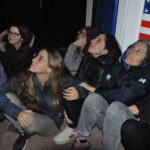
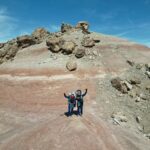
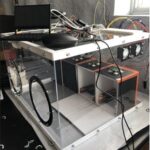
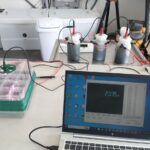
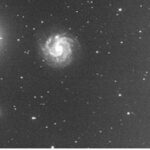
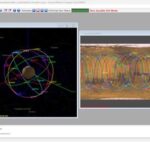
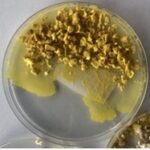
You must be logged in to post a comment.